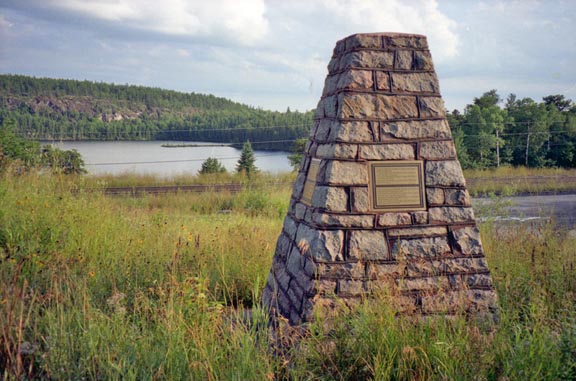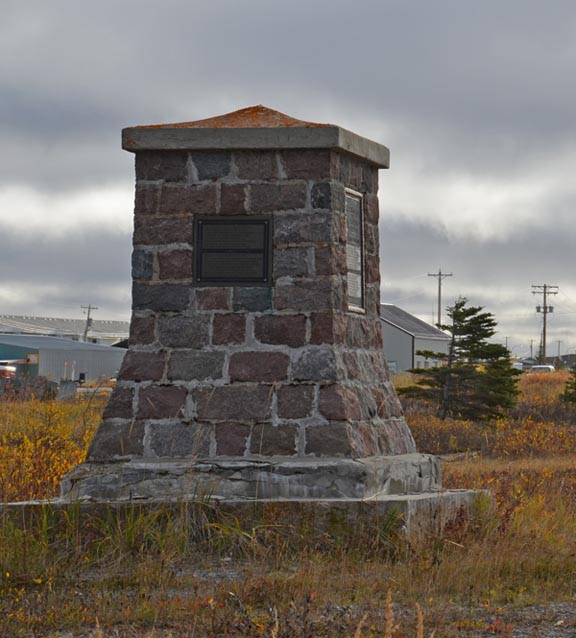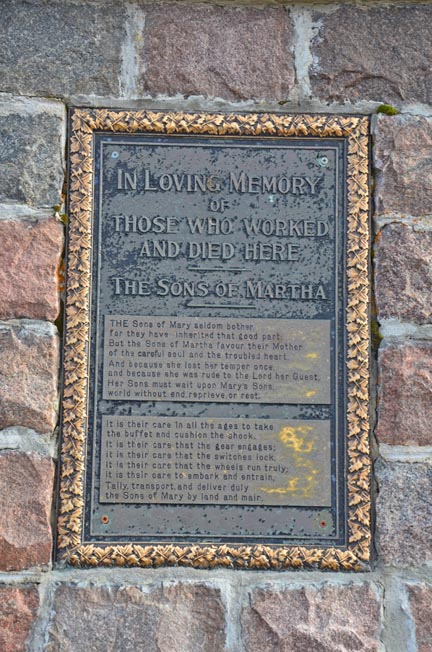 The Hawk Lake cairn with the CPR main line in the background.Photo taken in August 1993 by Colin Churcher The Hawk Lake cairn with the CPR main line in the background.Photo taken in August 1993 by Colin Churcher Note:
The article published in Branchline contains two editing typos for
Sherritt Junction and Moosonee. The text shown here is correct.
My Flickr pictures of the cairns can be found here:
https://www.flickr.com/photos/colinchurcher/albums/72157608120836931/
Harry McLean and his Dominion Construction and Grenville
Crushed Rock companies are well known to railway historians. McLean carried out many large construction
projects in eastern Canada and Manitoba in the 1920 – 1940 period. At eight of these projects McLean erected a
cairn to which was attached cast bronze plates on which were the words of the
poem “The Sons of Martha” by Rudyard Kipling.
This is a eulogy for the working man and McLean erected these cairns as
a tribute to his workers and, in particular, those who died on these projects.
McLean met Kipling a number of times in Canada, the first
being in 1907, likely in Montreal at McGill University. Kipling had an enthusiastic following of
engineers after publishing this poem whose biblical references speak of the
grave societal responsibilities of the engineer.
Mclean had sets of bronze plates cast with the words of
Kiplings poem, four plates for each cairn. Most were constructed of local stone
but a few were cast in concrete.
McLean’s name does not appear anywhere.
The plate on the front was engraved with the words “In loving memory of
those who worked and died here”, followed by the first two verses of the
Kipling poem. The remainder of the poem
was divided among three smaller plates, one attached to each of the other three
sides of the cairn. The locations and
details of the eight cairns in Canada are well documented in Teresa Charland’s
book [1] and I will just give a summary here.
The dates shown in the headings are the dates the cairns were erected.
Grand Falls
Hydroelectric Project, New Brunswick (1929)
This was opened on 1 October, 1928. The cairn here is a
concrete one.
Sherritt Junction,
Cranberry Portage, Manitoba (1929)
The Canadian National line to Flin Flon Manitoba was
officially opened by the premier of the province, John Bracken, on September
22, 1928. The stone cairn was erected near Cranberry Portage. This is sometimes erroneously referred to as
Flin Flon.
Guysboro Railway,
Nova Scotia (1929)
The Dominion Construction Company had the contract for the
construction of the Canadian National Guysboro branch from Sunny Brae to
Guysboro in Nova Scotia. Construction
started in November 1929 but the contract was cancelled in August 1930 after
some 22 miles had been completed. The
cairn was erected at Newtown, Pictou County overlooking the highway from Route
7 via Garden of Eden and Sunny Brae to New Glasgow (The Blue Mountain Road) [2]
Quebec City Wolfe’s
Cove Tunnel (1931)
The first train went through the Wolfe’s Tunnel in Quebec
City on May 26, 1931. This was a stone
cairn.
Moosonee, Ontario
(1932)
The Temiskaming and Northern Ontario Railway, later
Ontario Northland, was built in
sections. Dominion Construction was
responsible for the final section from Fraserdale to Coral Rapids to the Moose
River to Moosonee. The last spike ceremony took place on July 15, 1932. The Moosonee cairn is a concrete one.
Abitibi Canyon
Generating Station, Ontario (1932)
This project, some 70 miles north of Cochrane, was beset
with political problems. Work started in
1930 but the station did not come into operation until 1935. The cairn here is
a concrete one.
Harry McLean had two large quarries in Ontario which were
used to produce stone, mainly for ballast, on his many track widening and
rehabilitations projects.
Deeks Quarry (1925)
Deeks is located a few miles east of Merrickville on the
Canadian Pacific Winchester subdivision.
This also served as a storage and repair shop for the large amount of
equipment used on the many projects. A
large number of locomotives and cars were here at one time or another and I
have documented this in an article in the January 2009 Branchline. [3]
The last year of operation of the quarry was 1935. The stone cairn has been
vandalized.
Hawk Lake (1946)
Hawk Lake, near Kenora, was on the Canadian Pacific and the
quarry here was opened up in 1928 and the first full season was 1929.
The above account for eight cairns. There is a ninth
Washburn North Dakota (1952) To honor his parents in
North Dakota, McLean commissioned the Pioneer Family statue by Avard Fairbanks
that today stands on the capitol grounds. It was supposed to go to
Washburn, seat of the county named after his father. Somehow it was
sidetracked to Bismarck. So McLean put one of his Sons of Martha monuments
in Washburn.
However, there is a tenth Sons of Martha cairn which
was erected at Churchill, Manitoba,
in 1931, a few years after the Hudson Bay Railway was opened in 1929. It is a
stone cairn, similar to many of the others and the bronze plates would appear
to have been cast from the same moulds.
The stone must have been brought into Churchill from quite some way
away. The University of Manitoba digital
archives notes that the cairn in Churchill, was erected jointly by the Dominion
Engineering Co. and the C.N.R. The McLean Dominion Construction Company was not
involved in the construction of the line and the origins of the cairn remain a
mystery.

The tenth Sons of Martha cairn at Churchill, Manitoba.
Photo taken by Dennis Peters on September 28, 2011

The tenth Sons of Martha cairn at Churchill, Manitoba. Photo taken by Dennis Peters on September 28, 2011
The Sons of Martha
The Sons of Mary seldom bother, for they have inherited that good part;
But the Sons of Martha favour their Mother of the careful soul and the troubled
heart.
And because she lost her temper once, and because she was rude to the Lord her
Guest,
Her Sons must wait upon Mary's Sons, world without end, reprieve, or rest.
It is their care in all the ages to take the buffet and cushion the shock.
It is their care that the gear engages; it is their care that the switches
lock.
It is their care that the wheels run truly; it is their care to embark and
entrain,
Tally, transport, and deliver duly the Sons of Mary by land and main.
They say to mountains ``Be ye removèd.'' They say to the lesser floods ``Be
dry.''
Under their rods are the rocks reprovèd---they are not afraid of that which is
high.
Then do the hill-tops shake to the summit---then is the bed of the deep laid
bare,
That the Sons of Mary may overcome it, pleasantly sleeping and unaware.
They finger Death at their gloves' end where they piece and repiece the living
wires.
He rears against the gates they tend: they feed him hungry behind their fires.
Early at dawn, ere men see clear, they stumble into his terrible stall,
And hale him forth like a haltered steer, and goad and turn him till evenfall.
To these from birth is Belief forbidden; from these till death is Relief afar.
They are concerned with matters hidden---under the earthline their altars
are---
The secret fountains to follow up, waters withdrawn to restore to the mouth,
And gather the floods as in a cup, and pour them again at a city's drouth.
They do not preach that their God will rouse them a little before the nuts work
loose.
They do not preach that His Pity allows them to drop their job when they
damn-well choose.
As in the thronged and the lighted ways, so in the dark and the desert they
stand,
Wary and watchful all their days that their brethren's ways may be long in the
land.
Raise ye the stone or cleave the wood to make a path more fair or flat;
Lo, it is black already with the blood some Son of Martha spilled for that!
Not as a ladder from earth to Heaven, not as a witness to any creed,
But simple service simply given to his own kind in their common need.
And the Sons of Mary smile and are blessèd---they know the Angels are on their
side.
They know in them is the Grace confessèd, and for them are the Mercies
multiplied.
They sit at the feet---they hear the Word---they see how truly the Promise
runs.
They have cast their burden upon the Lord, and---the Lord He lays it on
Martha's Sons!
[1] Throughout this article I have used “Building an
Empire “Big Pants” Harry F. Mclean and His Sons of Martha” by Teresa Charland,
Riparian House 2007.
[2] The Guysborough Railway 1897 – 1939 by Bruce
MacDonald April 1973.
[3] https://churcher.crcml.org/Articles/Article2009_12.html
Bytown Railway Society Branchline - April 2015 also Ottawa Valley Associated Railroaders The Interchange April 2015
|



